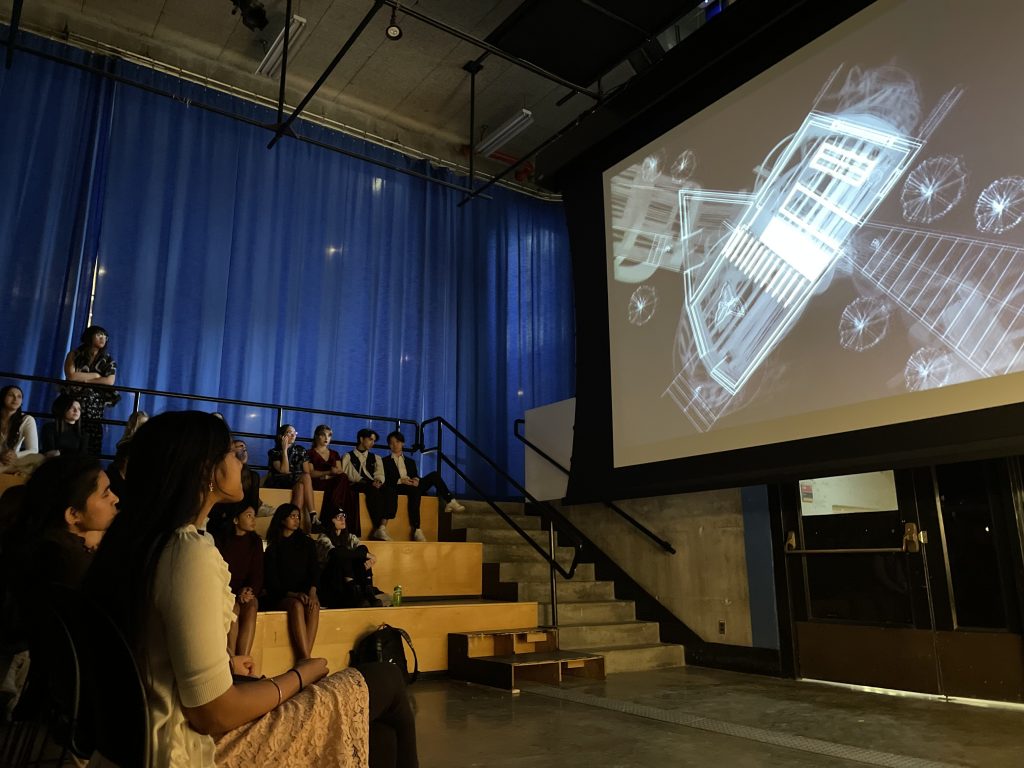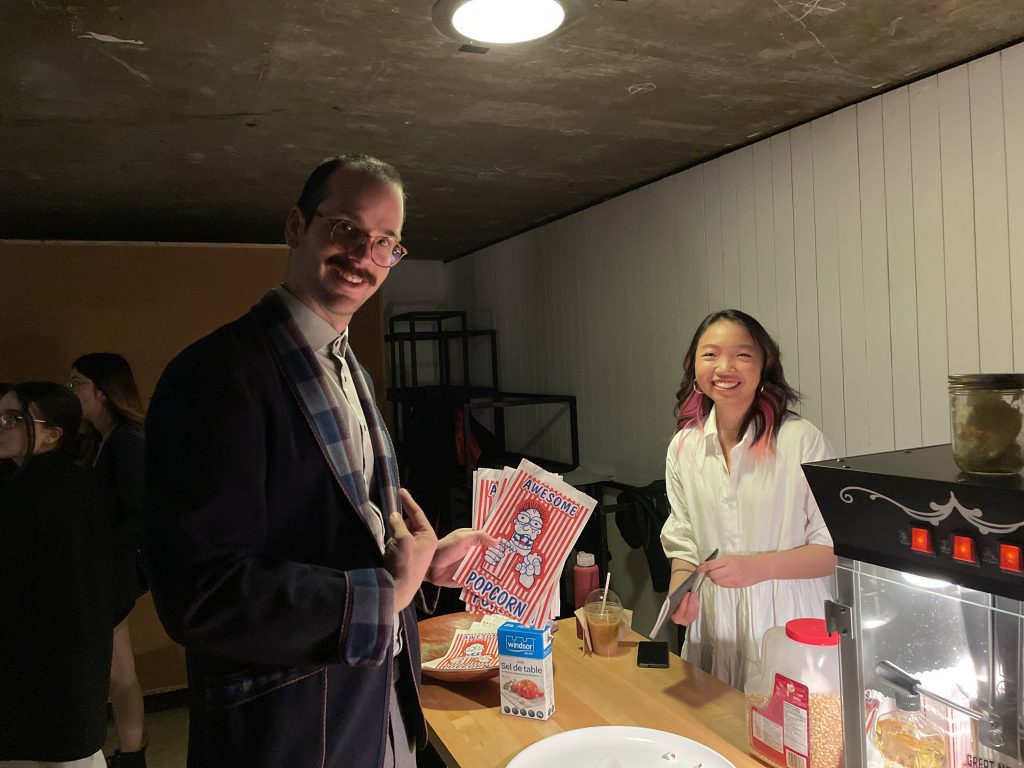Multimedia Oscars 2022: Student films depict a room for elusive dreams
December 10, 2022
A theatre-style popcorn maker, red carpet, and golden statuettes greeted guests at the annual “Oscars” ceremony, celebrating work by first-year students in the Introduction to Multimedia course.
The event in the Pit at the Architecture Building took place on December 7. It featured a screening of short films on the theme “a room for elusive dreams,” followed by an awards presentation. A panel of judges, Eric Archambault, Stephanie Murray, Damiano Aiello, and Gabrielle Argent, selected the following winners.
Best Picture: Maddy Lamey (Conservation & Sustainability)
Best Film Editing: Emma Yau (Urbanism)
Best Soundtrack: Penelope Gendron (Design)
Best Story and Screenplay: David Mokine (Design)
Best Visual Effects: Mang Vum (Design)
Best Scenography: Yasmeen Nabih (Design)
*
In addition, two students won an Honourable Mention:
Soundtrack: Amalia McCarthy (Design)
Visual Effects: Kimya Rose (Design)
*
See winning videos, jury comments, and jury profiles below.

Ninety-two out of 100 students submitted films for consideration.
“After two years of being confined behind a screen, it was such a wonderful and vibrant experience to celebrate first-year students’ hard work in person,” says Adjunct Professor Adriana Ross, who leads the course.
“All the entries were beautifully thought out and executed,” she says. “The judges were faced with tough decisions to pick six winners.
“What struck me the most was the overall enjoyment and participation of the students and the immense contributions of the teaching team to set up the event and create a memorable experience.
“This year, the school invested in a small movie theatre-style popcorn maker to make the movie screening experience even more realistic,” she adds.
Introduction to Multimedia introduces students to the theoretical, conceptual, and technical aspects of multimedia and is structured around two themes: Traces in Time and Reveal and Conceal.
The assignments incorporate work from the first-year drawing course. Students use their drawings as a basis to introduce and put into practice techniques such as digital photography, Photoshop, Illustrator, and videos that lead to creative transformations.
For the final assignment, Ross asked students to create a 30-to-60-second movie using any movie editing software. They were to deconstruct images, drawings, or models of previous assignments with animation and then reuse the leftovers or spolia as building blocks and materials. The goal was to design and construct a space for elusive dreams for someone and finally create an immersive atmosphere inside the room.
The prompts included the following: The cycle of a person’s life starts with the beginning of a new journey to a new ending that is a complex journey through a life of mixed reality in which the ephemeral existence of dreams and time collide to produce the physical and immaterial world in which we live.
“The objective is to create a well-crafted film that renders a consistent, compelling narrative to the viewer,” says Ross. “The film should show great intent, have an aesthetic consistency from the title sequence through to the credits and including the soundtrack.”
The teaching assistants were Caitlin Chin, Reem Awad, Hadiya Al-Idrissi, Simone Fallica, Harrison Lane, and Daniela Olivares.



Best Picture
Maddy Lamey — Waves of Inspiration
Student Statement: I wanted to show the creative process in a different way that focuses on trial and error and the disconnect between inspiration and circumstance. I find it hard to force myself to create, but during the semester, I had to learn how to push through when I wasn’t really feeling it instead of waiting for all of me to cooperate.
Jury Comments
A mature and polished vision. A soothing entry with wave sounds, restrained colour palette, and an inherent spatiality evocative of wide-open spaces. It delivers an experience as calming as reading your favourite book on the beach. The chapter structure works beautifully, as does the bookending of animations at the start and end.
Best Film Editing
Emma Yau — Wake Up
Student Statement: An elusive narrative illustrates the disorder of human imagination. Spolia of one’s dream is pieced together to represent the unconscious experience. A chaotic, tumultuous, immersive visual and auditory depiction aims to evoke the familiar sensation of being trapped in the manifestation of your own imagination.
Jury Comments
The creepy one. It starts innocently enough, then hits you with everything it’s got. Boldly aggressive in its use of jump cuts. It’s a dark architectural fever dream that grabs your attention and doesn’t relent.
Best Soundtrack
Penelope Gendron — La Feuille or The Leaf
Student Statement: La Feuille is a story about a lonely leaf that tries to find a place where she can connect to and feel as if she belongs but fails at the first attempt and because of that, she becomes lost. Though, with time she finds her way back and even discovers a place where others of her kind live. Her world now becomes alive.
Jury Comments
The audio was delicately incorporated into the film, well-timed and intentional. The subtlety and care for the audio reflect the student’s elegant approach to drawn media. A sensitively choreographed leaf journey set to an impossibly beautiful musical score. This one haunts you long after it’s over.
Best Story and Screenplay
David Mokine — Seeking Colour
Student Statement: My animation is about someone whose life is very black and white and mundane. They decide to go on a journey to try to find their colour. They stumble upon a gummy on the ground and decide to eat it. They are then hit with a wave of hallucinations in colour, causing them to lose balance and fall off the edge of a bridge. When they wake up, they start to see different colourful structures forming, showing that they have found that spark, and inspiration in their life.
Jury Comments
The jury appreciated the strong cohesion and evocative power of the storytelling. The dreamlike and hallucinatory atmosphere, emphasized by the use of vivid colours and immersive transitions, project the viewer into the perspective of the protagonist. An engaging altered-consciousness storyline of an architectural awakening, combined with inspired humour, make this one a standout.
Best Visual Effects
Mang Vum — Don’t Eat the Lotus
Student Statement: A metaphor for addiction, Don’t Eat the Lotus show the journey of the drug overtaking the user. The video begins with a lotus emerging from the concrete. The user eats the lotus and goes on a psychedelic trip that starts euphoric but quickly becomes overstimulating. We see the lotus unfolding to create the individual’s dream house. However, this dream house begins to warp and get distorted, cuing the deconstruction of this fantasy.
Jury Comments
An impressive re-crafting of assignments into kaleidoscopic visuals. The jury fondly referred to this film as ‘the pink one.’ Using a monochromatic palette to full effect against the white backdrop is pure genius. With dazzlingly hypnotic smooth-flowing images and professional-level character animation, this one belongs in indie animation festivals.
Best Scenography
Yasmeen Nabih — Little Nightmares
The atmosphere of this film is heavily inspired by one of my favourite indie horror games, Little Nightmares. We follow a little girl wearing a pointed hat with a ribbon on its end to help viewers follow her along her strange path. It starts in an unidentifiable place way beneath the foundation and debris of the city with a scary creature in the background growling ominously. As she progresses, the spaces become more abstract and open into impressive environments.
Jury Comments
The film succeeds brilliantly in combining assignments to shape a mutable and deeply immersive three-dimensional space. This piece features an unmatched degree of immersivity that truly takes us on a journey into another world. And what a wonderful ride it is. A chiaroscuro magnum opus that felt like watching the opening scenes of a video game. The wow factor is definitely strong in this one.
Honourable Mention (Soundtrack)
Amalia McCarthy — Dreaming Stars in Wonder
Student Statement: I based my multimedia project on this quote from Matt Haig’s, The Midnight Library. I wanted to explore the space concerning the in between; whether it’s in between ourselves, in between people, in between the increments of time we find ourselves lost in, and how it ultimately shapes our humanity and who we are through an existential approach.
Jury Comments
A brilliant use of rich and textural self-recorded voice, well-matched to the changing visuals and subtle auditory expressions of the characters, brings the animations to life.
Honourable Mention (Visual Effects)
Kimya Rose — Lady of Agony
Student Statement: My work describes a story of a girl and the journey of her transfiguration. I chose hues of white and blue to portray the idea of innocence, purity, and sadness. This journey represents the girl’s dream of becoming beautiful through alluring embroidery patterns and tracing paths of aesthetic lines. However, her dream is interrupted by her greed, and I used red hues on the lines to represent evil and anger. The beautiful shapes she has made abandon her, and she gets pushed out of her embroidery.
Jury Comments
A highly emotive journey draws out the protagonist’s plight and weaves her into a dire fate. Visually and materially rich, this film makes impressive use of physical models to outline a dramatic narrative.
About the Judges
Eric Archambault has been developing live visuals for electronic music performances in Ottawa-Gatineau since 2015. His live video remixes have been projected at venues such as the Ottawa Art Gallery, SAW Video Media Art Centre, and Daîmön centre d’art médiatique. Trained as an architect and documentary filmmaker, Archambault work explores our changing relationship with the built environment using lens-based recordings of the cities we live in as the foundation for live visual performances. www.vimeo.com/archamba
Stephanie Murray comes from a background of spatial investigations through critical making in the fine arts. From mixed media sculptural installations to professional and theoretical graduate studies in architecture, her research has continually probed how relationships to space are developed through bodily experience, material studies, and a multiplicity of narratives. Her current area of research focuses on Western Arctic landscapes and how water fluctuations affect the possibilities of habitation.
Damiano Aiello is a licensed civil engineer in Italy and has been a PhD student at the Azrieli School of Architecture & Urbanism since 2020. He is currently involved with Carleton Immersive Media Studio (CIMS), a research lab affiliated with the ASAU that focuses on advanced digital technologies and hybrid forms of representation. Aiello’s research looks at the social, cultural, political, and economic implications of the heritage paradigm defined by UNESCO, focusing on contested places.
Gabrielle Argent is an intern architect at Shean Architects and a contract instructor at the Azrieli School of Architecture & Urbanism. She holds a Master of Architecture (2020) from Carleton University and a Bachelor of Arts (Honours) in the History of Art, Design, and Visual Culture (2015) from the University of Alberta.